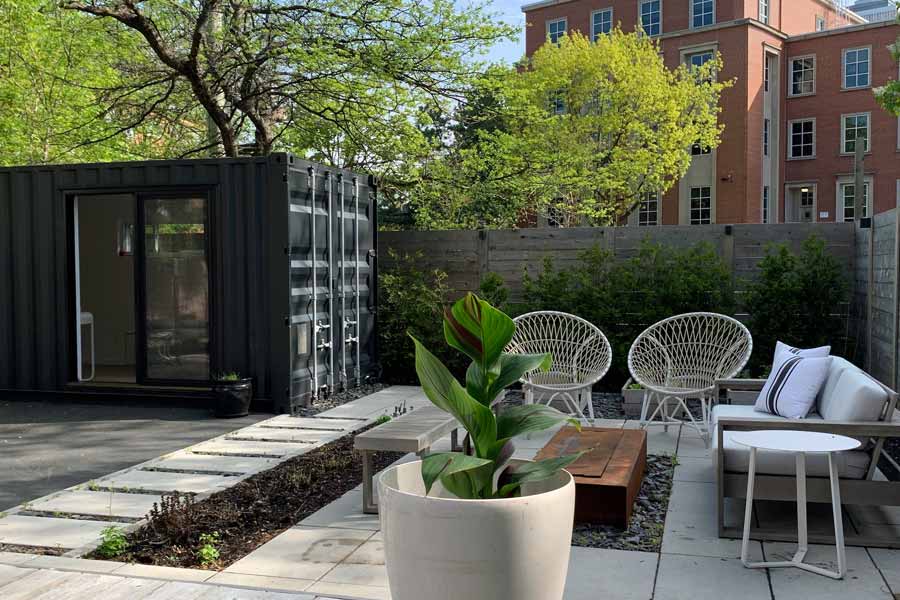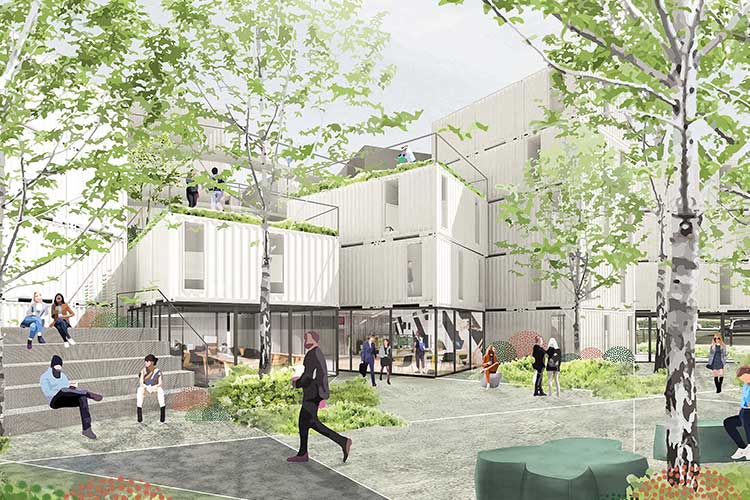Steel shipping containers have come a long way from their intended use to store and haul heavy cargo. They’ve become a hot trend in the construction and design industry, both for commercial and residential applications. In 2017, the global container homes market size was worth about $45 billion, and it’s expected to reach $73 billion by 2025.
In Canada, the concept ignited great interest in 2013 when a three-story development in Vancouver’s poorest neighbourhood was built with 12 upcycled shipping containers. Thanks to the COVID-19 pandemic, more people are working remotely, and shipping containers are emerging as a solution for dedicated backyard home offices.
Changing with the times
Due to increased demand, several Canadian cities including Ottawa, Vancouver and Halifax have recently relaxed regulations for homeowners wanting to expand their living space by using shipping containers on their properties. Other municipalities have passed legislation, launched pilot programs and clarified building codes to allow for coach houses, container dwellings or laneway houses.
Commercially, people who may have lost their jobs due to the economic downturn are pivoting to entrepreneurship, using containers as pop-up retail businesses. And some homeowners are building cottages from these repurposed boxes in their quest to escape crowds.
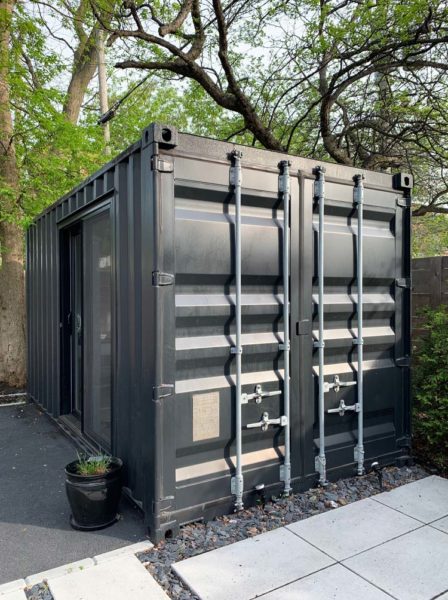
Then there are the big players: In 2019, Toronto-based LGA Architectural Partners created Stackt, Canada’s largest shipping container retail marketplace. Spanning two blocks, the project used 120 shipping containers, drawing accolades and awards.
Business is booming
Sturdy, affordable, portable and sustainable, shipping containers are having a moment, said Amy Thompson, president and co-founder of Northern Container Sales, an e-commerce sales and rental company in Toronto that launched several months ago and already has a foothold in five Canadian intermodal hubs—Calgary, Montreal, Edmonton, Toronto and Vancouver.
“There’s a rising demand for shipping containers because it’s an available resource that anyone can obtain quite easily,” Thompson said. “You don’t have to have a big plot of land or a large backyard depending on what your application is. That’s a big part of it. The other part is the dream: You see these fantastic builds that are just amazing, immaculate and beautifully finished, and people say, ‘That’s a container? I can do that!’”
Typically, shipping containers are either 8 feet by 20 feet or 8 feet by 40 feet. A used container in relatively good condition will run between CA$1,800 – CA$2,500 for the smaller size and up to $3,000 for the larger one, Thompson said.
“You can get quite a lot of square footage for not a lot of dollars,” added Thompson, who hopes to expand into additional markets in Canada soon.
Thompson’s customer base varies from industrial and commercial users to homeowners, campgrounds and storage companies. Customers place orders online, and her team works with global suppliers to deliver within seven business days.
“The beautiful thing with our design is that we hold nothing; we buy directly from manufacturers as the customer needs them, so I don’t have products sitting around in any one market waiting—it’s supply and demand,” Thompson said.
A broad appeal
Architects and designers love the endless possibilities of working with shipping containers, according to Greg Mullane, owner of SaltBox Modern Engineered Spaces, a three-year-old company in Halifax, Nova Scotia, that reimagines these used boxes into customizable, eco-friendly homes and business spaces.
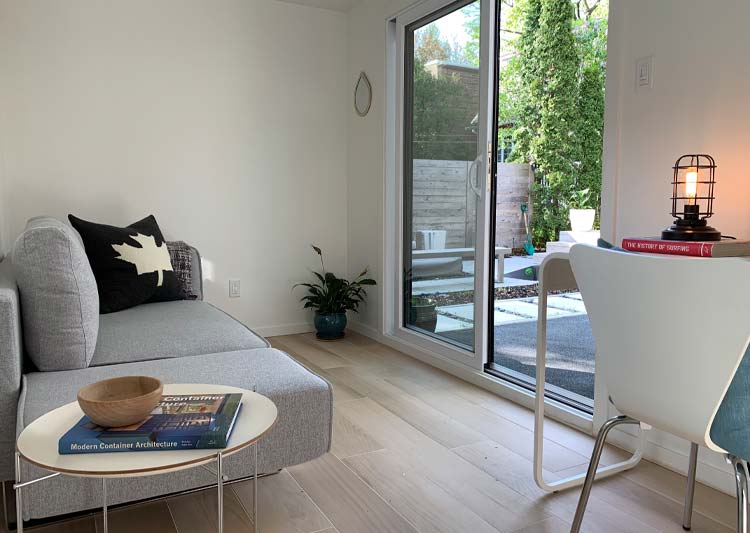
“I’m seeing a huge upswing,” said Mullane, whose background is in the landscape design-build space. “People are catching on and I’m getting more inquiries every day.”
“Last month, Halifax passed a bylaw allowing shipping container-type structures to be used as backyard dwellings or secondary suites, and that just opened the floodgates.”
Container units can be used for everything from in-law suites to rental properties and are easy to install and relocate, said Mullane, who has had requests for cottages, structures that can be used to operate a business as well as home offices.
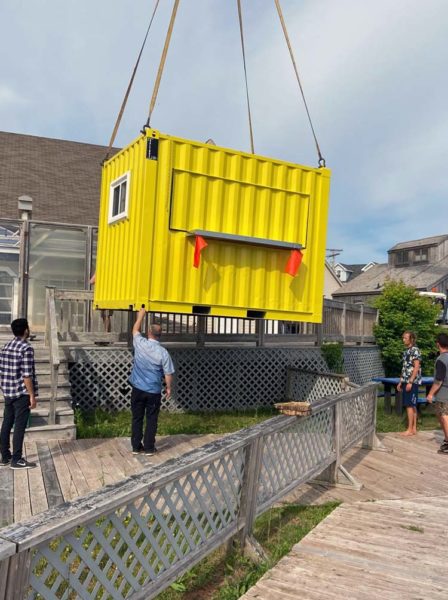
“I just had a woman inquiring about a backyard office, because her company is doing away with their corporate office and everyone’s going remote,” Mullane said, adding that customers appreciate how simple and affordable the process is.
“Right now, in the pandemic, the cost of building materials is skyrocketing,” Mullane said. “A shipping container is the structure, so the cost to build is better. The structure is meant to take a beating, and the maintenance is minimal. Installation is very easy on the Earth: For a backyard suite, we put it on a gravel path—there’s no digging, no machines banging off the trees and no diesel dripping into the ground. Within two hours, it’s sitting in your backyard and you’re done. Hook it up, plug it in, and go. And if you want to move, just put it on a truck and take it with you. Or sell it.”
When Montreal homeowner Teresa Mihalik needed extra space for a home office that doubled as a guest room, she wasn’t willing to give up her back deck to build an addition. Instead, she purchased an 8-foot-by-15-foot shipping container in 2017 which was transformed into a multi-purpose space. For under CA$10,000, including a tricky crane-in installation into her urban yard, Mihalik got a fully insulated, wired and furnished retreat.
“You can get really banged up ones, midrange, or almost-new-looking containers. Mine is the third category; it was clean with a few banged up spots, which I feel give it personality,” Mihalik said. “My container in the expensive category but was under $3,000.”
One box, many uses
This year, Mullane has built a stage for an outdoor amphitheater, two bars, a portable washroom for an outdoor beer garden and a pop-up for a T-shirt company. He said companies across Canada are innovating with out-of-the-box ideas.
For example, Honomobo’s modular home offices and bars are selling briskly across Canada and the U.S., while Modpools, located on the West Coast, is making a huge splash with its pools and hot tubs crafted from decommissioned shipping containers.
“What they’ve done for our industry is awesome,” Mullane said. “The company went so viral so quickly that they couldn’t even keep up with demand at first. The market is huge right now. In Halifax, it’s a two-year wait list to get a pool right now because of the pandemic; everyone’s staying home and it’s just one more staycation item people are going for.”
Photos courtesy of SaltBox and Teresa Mihalik

